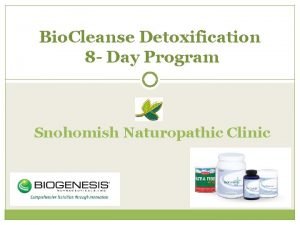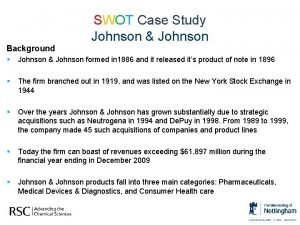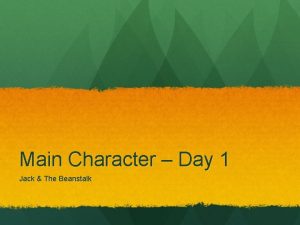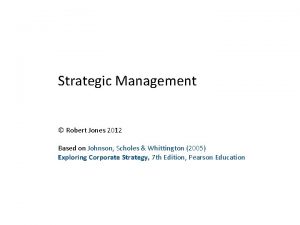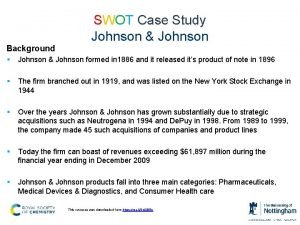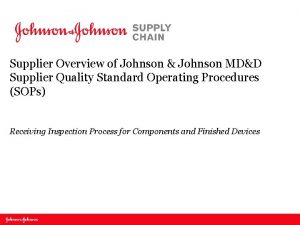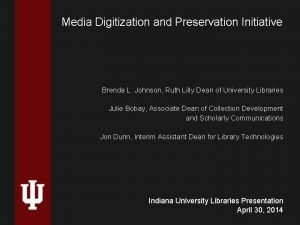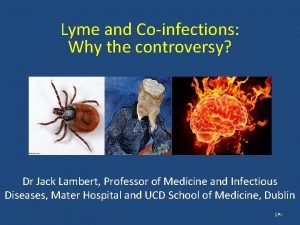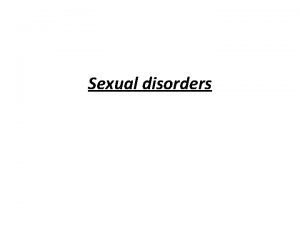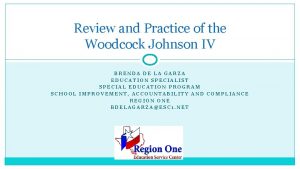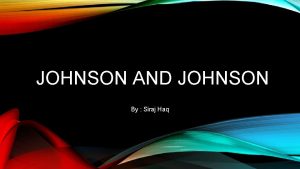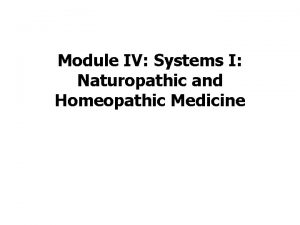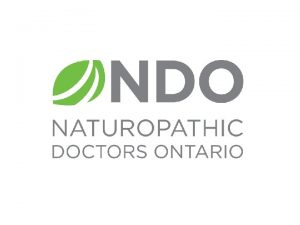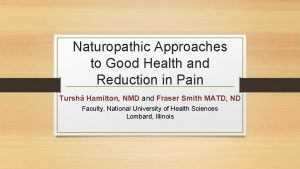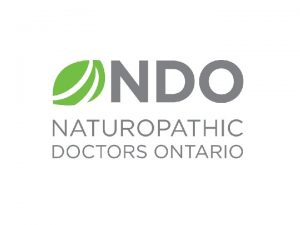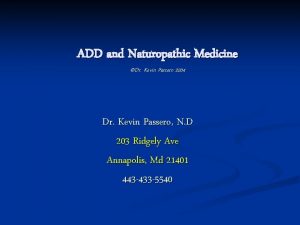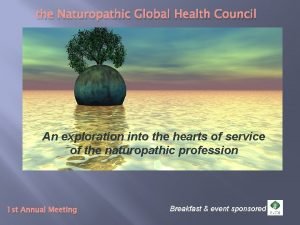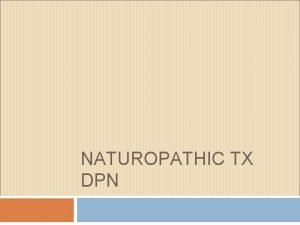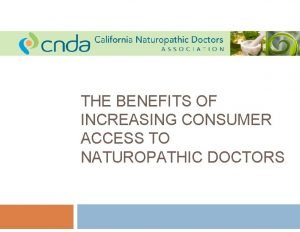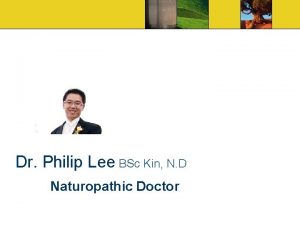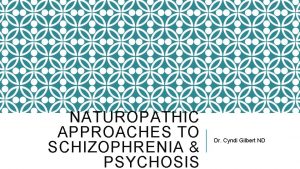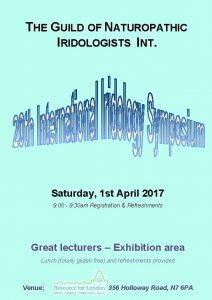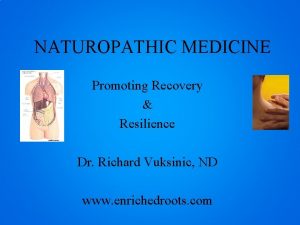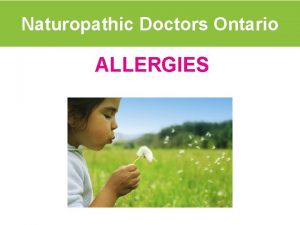DISEASE AND DISEASE A NATUROPATHIC PERSPECTIVE Jack Johnson



































- Slides: 35

DISEASE AND DIS-EASE : A NATUROPATHIC PERSPECTIVE Jack Johnson, ND

MAJOR SOURCES • American Association of Naturopathic Physicians • Natural Medicines Comprehensive Database • Up To Date • Bastyr University

PROFESSIONAL CONFLICTING INTERESTS • None

ABOUT ME • Born in Tacoma, WA • Graduated from Tacoma School of the Arts with a focus in nontraditional music • Completed undergraduate studies of pre-med and political science at the University of Washington, Seattle • Received Doctor of Naturopathic Medicine (ND) degree at the National University of Natural Medicine in Portland, OR. • Currently the resident physician at Peninsula Natural Health Center in Gig Harbor, WA.

RUSSELL

WHAT IS NATUROPATHIC MEDICINE • “Naturopathic medicine is a distinct primary health care profession, emphasizing prevention, treatment, and optimal health through the use of therapeutic methods and substances that encourage individuals’ inherent self-healing process. The practice of naturopathic medicine includes modern and traditional, scientific, and empirical methods. ”

PRINCIPLES OF NATUROPATHIC MEDICINE • The Healing Power of Nature (Vis Medicatrix Naturae) • Body’s inherent regenerative processes • Immune system • Example: A small wound • Debris removal • Platelet plug • Inflammation • Collagen deposition • Wound closure

PRINCIPLES OF NATUROPATHIC MEDICINE • Identify and Treat the Causes (Tolle Causam) • We do treat symptoms, however we also seek the ultimate cause and address underlying risk factors when possible. • Example: High cholesterol • Risk factors • Overweight • Poor diet • Lack of exercise • Smoking • Diabetes

PRINCIPLES OF NATUROPATHIC MEDICINE • First Do No Harm (Primum Non Nocere) • We follow a therapeutic order which helps us to use the least invasive/side effect inducing treatment that is effective for a condition. • Example: Plantar wart • Topical treatment like thuja prior to opting for surgical removal

PRINCIPLES OF NATUROPATHIC MEDICINE • Doctor as Teacher (Docere): • Our goal is to arm our patients with the understanding of their body and our treatment in order to encourage self-responsibility. • Example: Acne • Education around researched dietary aspects that may increase acne. • Patient is empowered to understand why their acne flares when they eat certain foods. Those foods become a risk v reward calculation.

PRINCIPLES OF NATUROPATHIC MEDICINE • Treat the Whole Person: ”Naturopathic physicians treat each patient by taking into account individual physical, mental, emotional, genetic, environmental, social, and other factors. ” • There are many determinants of health, some we can control and some we cannot. • Our goal is to understand as many factors as possible. • Example: High blood pressure • Contribute of stress • Family, work

PRINCIPLES OF NATUROPATHIC MEDICINE • Prevention: ”Naturopathic physicians emphasize the prevention of disease by assessing risk factors, heredity and susceptibility to disease, and by making appropriate interventions in partnership with their patients to prevent illness. ” • We will ask patients about their family history at first visit. • Example: Diabetes • If diabetes runs in the family, we will counsel regarding diet.

WHY I CHOSE NATUROPATHIC MEDICINE • I am not anti-conventional medicine. • Our team loves working in conjunction with our patient’s conventional physician, whether primary care or specialists. • I chose naturopathic medicine to address lifestyle factors and to increase the “tools in my toolbox. ” • Example: Drug allergies • Blood thinning: Warfarin v nattokinase • Testing: INR, bleeding time tests

NATUROPATHIC PRE-REQUISITES • Bachelor degree • College-level Algebra: 1 course • Chemistry* (science-major level): Minimum of 4 courses. Must include a minimum of either two sequential courses in organic chemistry or one course in organic chemistry and one course in biochemistry. (This latter option is highly recommended. ) (The standard prerequisite for sciencemajor level organic chemistry is one year of general chemistry. ) Appropriate, hands-on lab work required. (Hands-on labs are those taken in person or using home lab kits. ) • General Biology* (science-major level): 2 semesters or 3 quarters. Must cover concepts in cellular biology and genetics. Appropriate hands-on lab work required. Individual courses in the biological sciences may count if the above competencies are met, i. e. , anatomy, physiology, microbiology, and botany. • Physics: 1 college-level course. It must be algebra-based; calculus-based is also acceptable. A lab is not required. • Psychology: 1 course. Introduction to/ General Psychology or Developmental/ Lifespan Psychology.

ND CURRICULUM • 4 years, 5 if also studying another degree such as research. • Biomedical sciences (histopathology, cardiology, biochemistry, etc. ) • Clinical sciences (clinic physical diagnosis, diagnostic labs and imaging, etc. ) • Clinical rotations (family practice, focused) • Preceptorships (outside facilities)

LICENSURE • Prescriptive authority in WA state • All non-prescription substances • All prescription substances that are not controlled substances • Can prescribe Testosterone and controlled substances with less than 90 mg of codeine per dosage unit (example: tylenol with codeine) • Cannot prescribe methadone, hydromorphone (Dilaudid), meperidine (Demerol), oxycodone (Oxy. Contin), fentanyl, Dexedrine, Adderall, Ritalin • Different in Oregon, other states. • Lab tests and diagnostic imaging • Referrals • Minor procedures • Manipulation

BRIEF ASIDE REGARDING SUPPLEMENTS • They are not very strictly regulated by the FDA. • Means that it is possible they are advertising ingredients that aren’t actually in a product (this happened and has been widely publicized). • We only use supplement companies who are third party tested to ensure quality.

COMMON THINGS WE SEE • Overweight/unable to lose weight • High blood pressure • High cholesterol • Diabetes/high blood sugars • Pre-menopause/menopausal symptoms • Menstrual irregularities (heavy flow, irregular intervals, mood swings, pain) • Constipation/diarrhea/gas/bloating • Fatigue • Acne • Allergies • Primary care needs (physicals, medication management, referrals, labs, imaging)

WEIGHT LOSS • Very common thing we work on with our patient. • In the past, key to successful weight loss has been centered around healthy, whole food diets combined with exercise. • However, at some point, patient’s tend to plateau with these methods. • Especially difficult are perimenopausal and menopausal females. • Now, we are working with timing of food as well, which has unlocked an ability to increase weight loss. • One great book we recommend frequently is “Obesity Code” by Jason Fung, MD.

OBESITY CODE • Goes through human research and paradigms behind why we eat the way we do. • It’s not only about what you eat, it’s also about when you eat it. • Hormones: Insulin and Cortisol • Controlling insulin levels throughout the day in order to curb fat deposition. • While not mentioned in the book, further research has been performed regarding 12 hour window versus 8 hour window in mice. • For weight loss purposes, we tend to favor diets approaching a ketogenic type diet.

HIGH BLOOD PRESSURE • Most common form is primary (essential) hypertension • “Pathogenesis — Maintenance of arterial blood pressure is necessary for organ perfusion. In general, the arterial blood pressure is determined by the following equation: • Blood Pressure (BP) = Cardiac Output (CO) x Systemic Vascular Resistance (SVR) • Blood pressure reacts to changes in the environment to maintain organ perfusion over a wide variety of conditions. The primary factors determining the blood pressure are the sympathetic nervous system, the renin-angiotensin-aldosterone system, and the plasma volume (largely mediated by the kidneys). • The pathogenesis of primary hypertension (formerly called "essential" hypertension) is poorly understood but is most likely the result of numerous genetic and environmental factors that have multiple compounding effects on cardiovascular and renal structure and function.

HIGH BLOOD PRESSURE • “Risk factors for primary (essential) hypertension — Although the exact etiology of primary hypertension remains unclear, a number of risk factors are strongly and independently associated with its development, including: • ●Age – Advancing age is associated with increased blood pressure, particularly systolic blood pressure, and an increased incidence of hypertension. • ●Obesity – Obesity and weight gain are major risk factors for hypertension and are also determinants of the rise in blood pressure that is commonly observed with aging. • ●Family history – Hypertension is about twice as common in subjects who have one or two hypertensive parents, and multiple epidemiologic studies suggest that genetic factors account for approximately 30 percent of the variation in blood pressure in various populations. • ●Race – Hypertension tends to be more common, be more severe, occur earlier in life, and be associated with greater target-organ damage in [African-Americans]. ”

HIGH BLOOD PRESSURE • Risk factors continued. • “Reduced nephron number – Reduced adult nephron mass may predispose to hypertension, which may be related to genetic factors, intrauterine developmental disturbance (eg, hypoxia, drugs, nutritional deficiency), premature birth, and postnatal environment (eg, malnutrition, infections). • ●High-sodium diet – Excess sodium intake (eg, >3 g/day [sodium chloride]) increases the risk for hypertension, and sodium restriction lowers blood pressure in those with a high sodium intake. • ●Excessive alcohol consumption – Excess alcohol intake is associated with the development of hypertension. • ●Physical inactivity – Physical inactivity increases the risk for hypertension, and exercise is an effective means of lowering blood pressure”

HIGH BLOOD PRESSURE • Normal blood pressure – Systolic <120 mm. Hg and diastolic <80 mm. Hg • Elevated blood pressure – Systolic 120 to 129 mm. Hg and diastolic <80 mm. Hg • Hypertension: • Stage 1 – Systolic 130 to 139 mm. Hg or diastolic 80 to 89 mm. Hg • Stage 2 – Systolic at least 140 mm. Hg or diastolic at least 90 mm. Hg

HIGH BLOOD PRESSURE • Our approach • Weight loss • Alcohol reduction • Salt restriction (DASH-S diet) • Pharmaceuticals or supplements for blood pressure reduction as required

HIGH BLOOD PRESSURE • Non-pharmacological treated studied to have benefit in reducing blood pressure. • DASH and DASH-S diet • Alpha linolenic acid (an essential fatty acid) • Black seed (fennel flower) • Blond psyllium (plantago ovata) • Calcium • Cocoa • Coenzyme Q-10 • Fermented milk • Fish oil • Flax seed • Folic acid Most common for us is “Carditone” which primarily inhibits firing of sympathetic nerves causing upregulation of blood pressure. • • • GABA Green tea Guar gum Hibiscus L-arginine Lycopene Melatonin Nattokinase Olive Potassium Vitamin C Wheat Bran

HIGH CHOLESTEROL • Produced by the liver and also garnered from the diet. • Cholesterol is a precursor to steroid hormones. • Recommended values • “Total cholesterol below 200 • LDL cholesterol below 130 – or much lower, if they are at risk of heart attacks or strokes • HDL cholesterol above 60 (generally lab values low threshold is 40) • Non-HDL cholesterol below 160 – or lower, if they are at risk of heart attacks or strokes • Triglycerides below 150”

HIGH CHOLESTEROL • Our approach • Healthy weight loss • Whole food diet • Pharmacologic agents and supplements as indicated

HIGH CHOLESTEROL • Many non-pharmacologic treatments have been studied with positive effect of cholesterol reduction and generally HDL increasing. • Many of the blood pressure reducing agents lower cholesterol as well. • Our favorite to use is Red Yeast Rice which is a naturally occurring HMG-Co. A reductase inhibitor (inhibits cholesterol production in the liver). • Choleast is the particular product we use. • We always take into account ASCVD score prior to prescribing statins. • 10 year risk of heart disease and stroke.

PRE-MENOPAUSE/MENOPAUSAL SYMPTOMS • Hot flashes, irritability, mood swings, and sleep disturbances. • Our favorite product is Menocaps • Herbal ingredients • Black cohosh, for example, studied to have similar benefits to low dose transdermal estradiol.

UPSET STOMACH (IRRITABLE BOWEL) • Very common. • Forms can range from constipation to diarrhea. • Normal bowel movement is generally considered to be a 1 -3 Bristol Type 3 or 4 stools daily. • We often use Bio-Gest as digestive aid. • Bloating and gas is common. • Occurring with high fiber meals? • Small intestine bacterial overgrowth

SMALL INTESTINE BACTERIAL OVERGROWTH • A relatively new diagnosis. • Considered an underlying factor for a number of cases previously diagnosed with Irritable Bowel Syndrome. • Jejunal aspiration is the gold standard for diagnosis (middle part of the small intestine), but this is inconvenient and difficult to find a gastroenterologist who performs them. • Instead, breath tests are used. • We prefer lactulose breath tests which test for hydrogen and methane overgrowth. • We often use Allimax and Berberine.

FATIGUE • Many causes! • We want to rule out systemic disease first, including infection and inadequate iron or other forms of anemia. • One product we use often is Adaptocrine. • Herbal ingredients including ginseng and ashwagandha. • Back by positive studies but not well understood why the work.

ACNE • Contributing factors include hormonal dysregulation, diet, stress • SUGARS and in some individuals, dairy, are particularly culprits. • For sugars, increase in IGF-1 correlated with increase DHEA and other androgen precursors. • Then turned into testosterone which increases oil production and leads to acne.

QUESTIONS? • Thank you!
 Snohomish naturopathic
Snohomish naturopathic Johnson and johnson swot
Johnson and johnson swot Main characters in jack and the beanstalk
Main characters in jack and the beanstalk Johnson and johnson bcg matrix
Johnson and johnson bcg matrix Johnson and johnson organizational structure
Johnson and johnson organizational structure Johnson and johnson credo
Johnson and johnson credo Johnson and johnson botnet infections
Johnson and johnson botnet infections Johnson and johnson swot analysis
Johnson and johnson swot analysis Jjeds johnson and johnson
Jjeds johnson and johnson Dreikurs classroom management theory
Dreikurs classroom management theory Johnson and johnson md&d
Johnson and johnson md&d Laurie johnson brad johnson
Laurie johnson brad johnson Dr jack lambert lyme disease
Dr jack lambert lyme disease Bharathi viswanathan
Bharathi viswanathan 1 point perspective house
1 point perspective house Silo perspective vs business process perspective
Silo perspective vs business process perspective Madeleine astor
Madeleine astor Food chain with labels
Food chain with labels Jack and the beanstalk short story
Jack and the beanstalk short story Exposition of jack and the beanstalk
Exposition of jack and the beanstalk The real story of jack and the beanstalk
The real story of jack and the beanstalk Jack and his mother were hungry
Jack and his mother were hungry Jack london naturalism
Jack london naturalism Jack once upon a time
Jack once upon a time Jack and the giantess
Jack and the giantess Jack and jill french revolution
Jack and jill french revolution Hello my name is jack and this is sue
Hello my name is jack and this is sue Jack and jill psychosexual fixation
Jack and jill psychosexual fixation We might get taken prisoner by the reds
We might get taken prisoner by the reds 1917 movie map
1917 movie map Subdividing ratios
Subdividing ratios Adam sandler monica
Adam sandler monica Biopsycosocial
Biopsycosocial Woodcock-johnson test sample
Woodcock-johnson test sample Master and johnson squeeze technique
Master and johnson squeeze technique Beer johnston
Beer johnston
